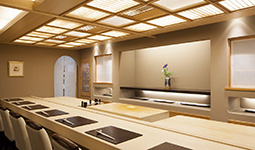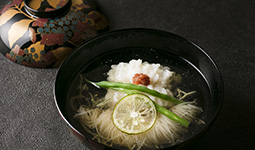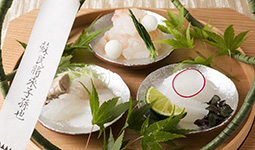June 2022
- English
- 日本語
A Chinese Chef Training at a Japanese Restaurant

Ginza Kojyu master Okuda Toru (right) and Wang Junpeng 
A dish featuring sweetfish

Wang at work in the kitchen 
The counter at Ginza Kojyu 
Daggertooth pike conger (a kind of eel) and somen noodles in soup served in a bowl with a hydrangea pattern (see lid upper left) 
Example of an otsukuri (sashimi) dish

Wang Junpeng from China is studying Japanese cuisine at a prestigious restaurant in Ginza, Tokyo.

In 2013, “washoku” was inscribed on UNESCO’s Representative List of the Intangible Cultural Heritage of Humanity. Following this, the Ministry of Agriculture, Forestry and Fisheries of the Japanese government announced the “Human Resource Development Program to Spread Japanese Food Culture Overseas,” a culinary training program launched in 2014 through which it has been supporting foreign chefs studying Japanese cuisine.
Chinese Wang Junpeng who is training at Ginza Kojyu, a highly regarded* and prestigious Japanese restaurant in Tokyo, is also one of the trainees in this human resource development program. Wang is presently in his third year of training. Standing in a tense kitchen together with more than ten Japanese who aspire to become first-class chefs, they are steadily becoming more skilled under the guidance of their master, Okuda Toru, a man who allows no compromise.

Wang explains, “The boss** is tough, but if you try to learn, he responds in kind. The trainees, working together, also teach each other things we don’t understand, working hard to improve each other. The Kojyu kitchen is an optimal learning environment.”
When Wang was staying in Japan as a language student, he was invited by a Chinese friend attending a Japanese cuisine vocational school to experience it, and he was impressed by the Japanese cuisine he encountered there. “Japanese food is healthy, simple and very delicious, but when I saw how it was made, I was surprised at how carefully and delicately everything was done, from the extraction of broth from bonito and kelp to the processing of ingredients such as fish,” says Wang. “I really want to learn about Japanese cuisine,” so he decided to enroll in the vocational school.

At school, he learned how to handle and care for kitchen knives, of which a different type is used depending on the ingredients, and the basic technique for peeling radish and other ingredients thinly without breaking the peel, which is known as “katsura peeling.” At the end of the three years, Wang had achieved excellent grades and was accepted to undergo training at Ginza Kojyu, which had been his long-cherished wish.
At Ginza Kojyu, students learn not only the cooking techniques of Japanese cuisine such as boiled and flame-broiled foods, but often also acquire knowledge about Japanese tea and sake as well as approaches to customer service. In addition, Japanese cuisine is characterized by the use of “seasonal” ingredients that are only available or said to be the most delicious at certain times of year, making you feel the season with your five senses, through colors and aromas. As such, it is difficult to learn because you cannot cook the same dish for a full twelve months, all year around. However, Wang believes that this is a very important part of the spirit of Japanese cuisine.

Wang says, “I think that a heart of hospitality that wants customers to enjoy the season lies at the root of Japanese cuisine. For example, even at Kojyu, we have something called ‘utsuwa dashi’ where we change the tableware every month, for example using bowls with a hydrangea pattern during the season now.” Since enrolling in his vocational school classes, Wang has also studied Japanese flower arrangement and calligraphy. Even now, on holidays, he visits shops specializing in Japanese tableware and cultivates his ability to appreciate it.
After completing his five-year training period, Wang hopes to eventually open his own restaurant in Shanghai. He says, “With that restaurant, I don’t just want to focus on the food, but I also want to take care with everything else such as furnishings and implements. I want to introduce Japanese cuisine along with the Japanese culture I have learned.” Speaking of his dream, he comments, “Beyond that, I want to create dishes unique to Shanghai and convey techniques and ways of thinking in Japanese cuisine to China.”

Not limited to Japanese cuisine, any food culture that has inherited the wisdom of people in the past and has been nurtured by a long history make up a human legacy that transcends nationality. The day will come when Wang, a man from China that is home to one of the world’s greatest food cultures, will create dishes that are unique to him, based on his experience in Japan.
* Obtained two Michelin stars in 2022
** Referring to Okuda

